![]()
![]()
![]()
Lembeh Resort Dive Centre

Lembeh Resort Dive Centre
 Lembeh Resort's dive centre is quite extensive when I think about it. In addition to the tanks, outdoor showers, whiteboards and the usual place for guests to hang their wetsuits and equipment, there's also a security hut, a dive shop, a private upstairs lounge for the staff, the tank-filling corner and a very thoughtfully-done camera room.
Lembeh Resort's dive centre is quite extensive when I think about it. In addition to the tanks, outdoor showers, whiteboards and the usual place for guests to hang their wetsuits and equipment, there's also a security hut, a dive shop, a private upstairs lounge for the staff, the tank-filling corner and a very thoughtfully-done camera room.
But let's start with the basics first. When you check in, the resort will ask you if you'd like them to bring your dive bags straight to the dive centre. If you are like us and pack your clothes and toiletries into the dive bags, that's fine, because then they'll send all your luggage to your room where you can separate the dive stuff from the non-dive stuff, and when you're done, just call their front desk and someone will turn up to bring the dive stuff to the dive centre. (Or you can bring it yourself - and if you learn the Lembeh Resort Way fast enough, that could well be the last time you carry your dive gear in the resort.)
Buyat Bay
If you're planning to stay for more than a week, you might want to consider a few days at Buyat Bay. Lembeh Resort organises expeditions to this new area of un-dived sites, up north. It takes a few days, and includes "basic accommodation" (but their definition of basic is airconditioning and hot running water with no mandi-style bathing, hence I love them very much). Food is mainly rice and fish.
The boat trip there takes many hours, but you will stop for dives all the way there, so you probably won't feel it.
I haven't tried the trip myself, so I can't do a review here, but I would like to one day.

At the dive centre, hang up your wetsuits and place your dive equipment into your designated 'closet'. We also stored our mesh bags in the camera room along with our camera stuff. But more on the camera room later. You will then need to go to the dive shop to fill in the usual dive forms. (When we went, the dive centre manager met us at check-in and arranged for a time to meet at the dive shop.) Someone, if not the manager, will also show you round the dive centre and explain how it runs. Try not to leave all this to the morning of your first dive, because there isn't enough time between breakfast and the boat departure time to do all this.
As the resort is very popular, there will be many divers. But even at full capacity (28 pax), there will never be more than 4 divers per guide. In fact, the resort usually tries to keep it to 3. The resort will figure it all out for you, so you only need to check the main whiteboard to find out your guide and boat. You will also see which dive sites you're going to for the day. Your name will automatically be put down for all 3 day dives, with an "N" next to your name if you're on Nitrox. If you don't want to go for any of the dives, just write down "No" next to your name in advance. If you want to go on the night dive, just put your name down (they need minimum 2 names for a night dive). Same for the guided or unguided house reef dive, just put your name down in the designated column on the whiteboard.
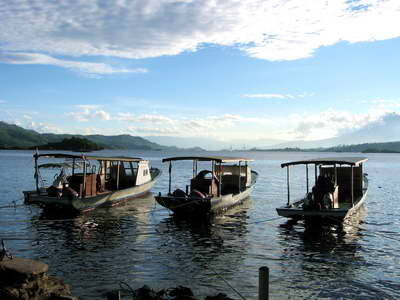 You put on your wetsuit in the dive centre before getting on the boat. If you're using Nitrox, you must also remember to analyse your tank (you'll do this together with one of the guides or crew), and sign your name on the clipboard list. The crew will then rig up your BCD to your tank, and carry the whole load including your fins onto the boat as you get ready and listen to the briefing. The crew will also bring your camera onto the boat when you're just about to leave. The crew know that cameras are to be treated like babies, so you can trust them with your Precious. (But be warned that if your camera is the kuniang weightless kind like mine and can be carried with one finger, then it may not always make it to the Boat Butler Service List. Many a time my little Canon IS was left floating in the water of the camera tank, all by itself, while all the big fancy setups had been personally chauffeured to the boat. Not that I mind though - I just wanted to mention it because it's very amusing.)
You put on your wetsuit in the dive centre before getting on the boat. If you're using Nitrox, you must also remember to analyse your tank (you'll do this together with one of the guides or crew), and sign your name on the clipboard list. The crew will then rig up your BCD to your tank, and carry the whole load including your fins onto the boat as you get ready and listen to the briefing. The crew will also bring your camera onto the boat when you're just about to leave. The crew know that cameras are to be treated like babies, so you can trust them with your Precious. (But be warned that if your camera is the kuniang weightless kind like mine and can be carried with one finger, then it may not always make it to the Boat Butler Service List. Many a time my little Canon IS was left floating in the water of the camera tank, all by itself, while all the big fancy setups had been personally chauffeured to the boat. Not that I mind though - I just wanted to mention it because it's very amusing.)
There's usually a lot of space on the boat. Each boat is equipped to carry about 8-10 divers, but with 4-5 boats at the resort, you are highly unlikely to share the boat with more than 5 other guests. On the boat, you just sit until you reach the dive site, when you put on your BCD and fins and enter into the water by a back roll. The crew will pass you your camera after you're in the water. Oh, and don't worry, the boat has a ladder!
After your dive, the crew will pass you a towel and fresh fruit like sliced pineapple or bananas. After a night dive, the crew will also make you hot tea. The towel's just meant to pat you dry, and therefore won't have the freshly laundered scent every single time, so don't use it to ... I don't know, clean cuts or wipe eyes, you know what I mean?
When you return to the resort after your dive, you can leave your BCD and fins on the boat, and just hop off with your camera. I prefer to leave my wetsuit on until I reach land, as I would have too many layers to carry off the boat by hand otherwise.
There are plenty of dunk tanks, and they're large enough to carry several camera setups. There are also two showers, and each comes with a foot tap.
Camera Room
The camera room has enough camera tables for every guest, and each table comes with a wall shelf and a hand towel. On top of that, there's boxes of facial tissue, two different types of voltage, plenty of powerpoints for charging your batteries, a tool box with things like screwdrivers, scissors, cable tie, soldering iron, tape - just about everything! There was also free-flow lint-free tissue the last time we went (2009) but I've heard that that's no longer available. The floor is covered with rubber mats, so you won't slip and drop your raison d'etre. There are conveniently located wastepaper baskets, and - I'm saving the best for last - an air-gun powered by a tank. If you need to change your batteries or card quickly in between dives and can't wait to let your camera dry overnight, use the air-gun. I know I sound like a broken record, but really, the camera room is wonderful.
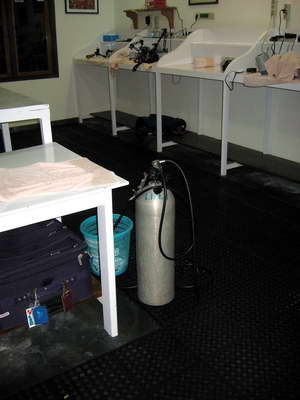
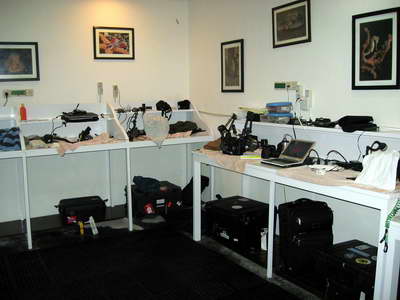
Above: The camera room has an air-gun and many tables for cameras
 Dive Briefings
Dive Briefings
Dive briefings take place at the dive centre after you're done donning your wetsuit, and before you board the boat. The briefing basically gives you essential information about the dive site (eg white or black sand, sloping or flat, general route, maximum depth) and the marine life you might see. The guide will also draw out the site on a little white board for you to get a clearer picture of your dive. He will also tell you the maximum dive time.
Often, the guide will refer to a collection of pictures below the noticeboard, or pull out a folder which has more pictures of the marine life you will see. A simple touch, but it makes a world of difference when the guide says 'we may see a <word you've never heard of>', points to the picture and you go 'aaah!' (lightbulb goes off in head).
Dive Guides and Crew
The most practical thing to do when diving in Lembeh, is to follow your guide. In this way, you will see the best that the Lembeh Straits has to offer, you will not get lost, and you will not have to huff and puff a hundred metres back to the boat after surfacing.
You may not be assigned the same guide throughout your stay, especially if you're there for a week or more, but all the guides at Lembeh Resort are good and know where to find critters. We had excellent dives with all our guides, who were Yopie, Gayius, Oksin, Andi and Ronald. Oksin and Andi are sweeties, Gayius will make you laugh, and Ronald and Yopie were exceptionally good.
The boat crew and guides will:
Chivalry meter: GOOD
Surface Intervals
Sometimes you will have two-tank dives in the morning, so you'll spend some surface intervals on the boat. Other times the boat will return to the resort where you can spend your surface interval lounging by the pool in or out of your wetsuit, whatever pleases you.
A Typical Dive Day
Here, if the whiteboard says your dive is at 8am, it means your dive briefing is just before or at 8am, and your boat will leave pretty soon after. So, you should be at the dive centre say 15 mins early to analyse your tank and struggle into your wetsuit.
If you're on their dive package, you also get one free shore dive a day, and if you go on an unguided shore dive then the timing is up to you.
6.30am Wake up. Go to the toilet, brush your teeth, put in contacts.
6.45 Go to camera room, set up camera and dunk. Check that your name is on the noticeboard for all the dives :-)
7.00 Breakfast
7.20 Return to room. Sit on throne if necessary. Wash up.
7.45 Go to the dive centre, analyse both tanks for the morning, and put on your wetsuit. Your equipment will already be rigged up to the tank (Nitrox would already be analysed) and on the boat.
8.00 Dive briefing. If you have a big camera sitting in the dunk tank, the crew will help you bring it onto the boat just before you leave
8.05 Leave for 1st dive site, which is likely to be less than 20 minutes away by boat. .
9.45 Return to resort. Hang out by the pool.
10.30 Back to dive centre, put on wetsuit, attend dive briefing
10.45 Leave for 2nd dive.
12.00pm Return to resort. Shower, lunch.
1.15 Back to room for nap.
2.10 Wake up, go to the dive centre, analyse tank, dunk camera, put on wetsuit, attend dive briefing.
2.30 Leave for 3rd dive.
4.00 Return to resort. Shower, back to room for nap.
6.00 Wakey wakey, back to dive centre, analyse tank, put on wetsuit, attend dive briefing (or if you're going on an unguided house reef dive, just fill in the log, switch on the house reef light, and go).
6.15 Leave for night dive
7.15 Back to resort. Attend to camera, check noticeboard. Shower, dinner.
9.00 Back to room, look through photos.
10.00 Sleep
Note: If you opt for the Mandarinfish dive, it will start about 5.15pm. There will be no night dive after that.
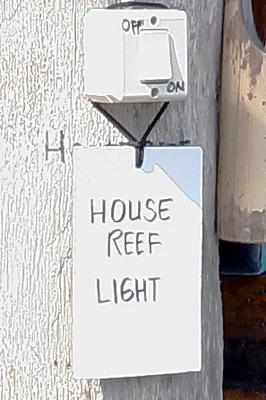 Shore Dives
Shore Dives
If you want to explore Lembeh Resort's house reef with a shore dive, you can choose to do it yourself, or do it with a guide. We tried an unguided shore dive, and the resort has very thoughtfully provided a trail of floats to guide you. And this trail of floats is not a short one that disappears after five kicks of your fins, but goes for a quite a distance.
If you go for a shore dive, you must switch on the House Reef Light, which is clearly marked at the dive centre. This is to alert all boats in that area.
You also need to put your name down on the whiteboard in advance so that the crew will prepare a tank for you. You must also fill in the shore dive log, which is on a clipboard hanging next to the whiteboard.
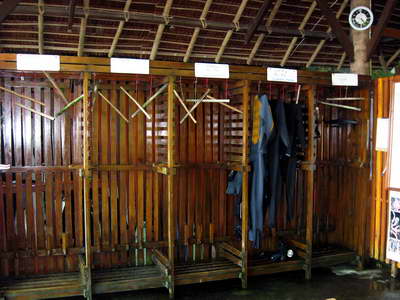
Rows of 'closets'
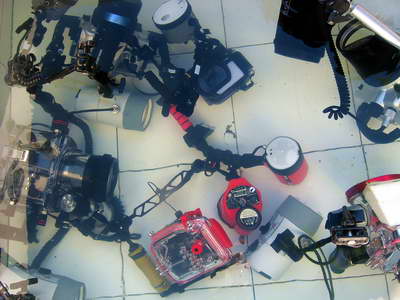
One of the dunk tanks with a few cameras inside

The dedicated camera room
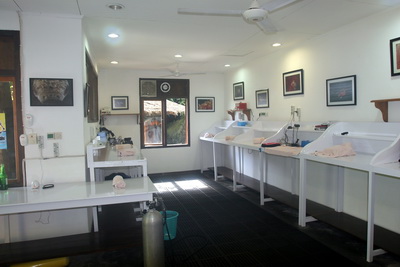
Spacious and airy
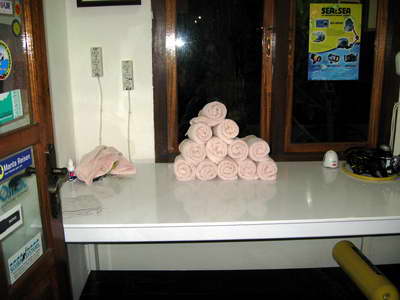
Your camera gets its own towel
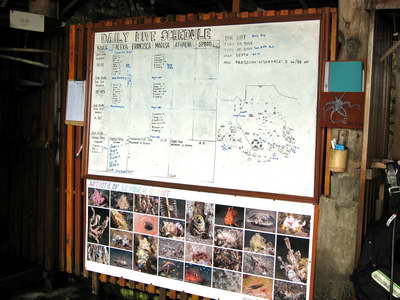
Below the noticeboard are big pictures of the creatures you might see
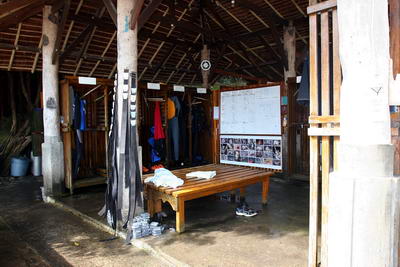 Where you put on your wetsuit and have the briefing
Where you put on your wetsuit and have the briefing

The adjacent briefing / changing area for other groups so that each group has their own undistracted briefing
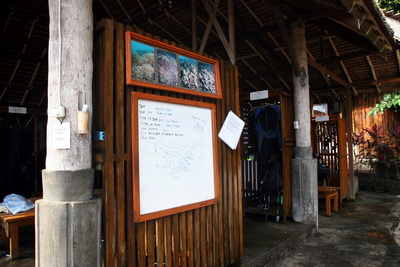
Yet another whiteboard for separate briefings - it's really very well-organised

Water dispenser on the boat
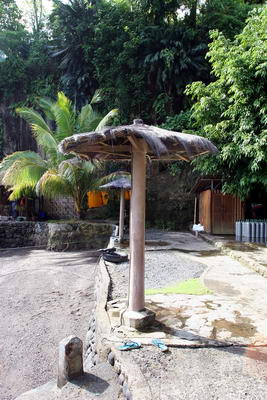
One of the two showers
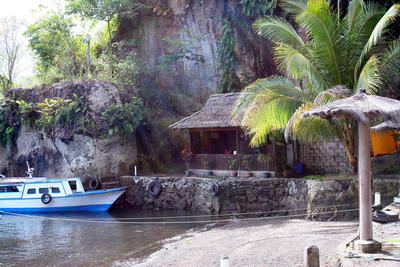
The hut with the thatched roof is the security post

Outdoor drying for the Toasty Wetsuit Feel
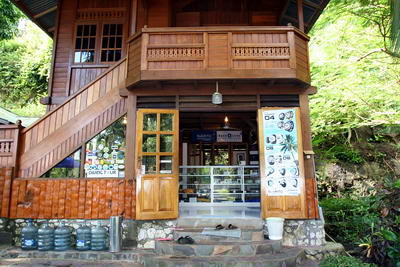
The entrance to the dive shop. The staircase leads to the private staff lounge.
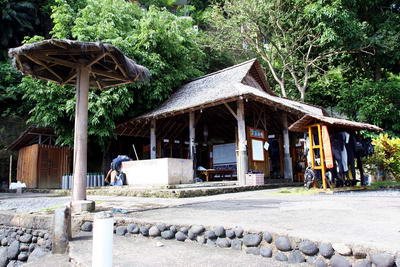
The dive centre viewed from the water's edge
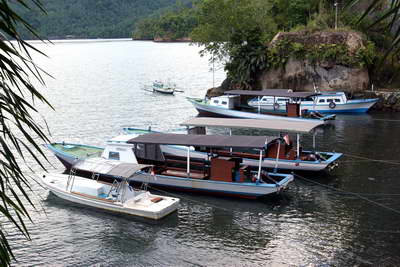
The boats are all reverse-parked neatly